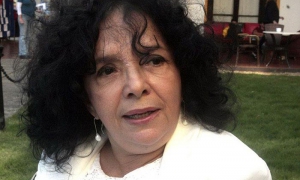A singular institution exists in Havana, located at 17th and E Streets in the neighborhood of Vedado - an artistic and historical oasis which captures the attention and sensitivity of visitors. Simply passing over the threshold of the door to the National Museum of Decorative Arts is the beginning of a voyage through art history, and an opportunity to interact with a variety of cultures. The National Decorative Arts Museum hosts events for both specialized groups and the community. The beautiful edifice housing the museum, which celebrated its 50th anniversary July 24, was designed by the French architects P. Virad and M. Destugue, specialists from the Jansen House in Paris, and was constructed in 18th century French style, with floors of Italian marble, in 1924. It was one of the residences of María Luisa Gómez-Mena, better known as the Countess of Revilla de Camargo. In 1964, it became one of the first museums established by the Revolution, inaugurated by Marta Arjona, with Alejo Carpentier making the ceremony’s opening remarks. The institution holds more than 33,000 pieces of artistic-historical value, ranging from varied European and Eastern decorative art works from as early as the 16th century through the present. Some of these are from the reigns of Louis XV, Louis XVI, Napoleon III, Oriental pieces from the 16th to the 20th century, as well as articles manufactured in the French cities of Sevres, Paris, Limoges, Chantilly, and in Britain – Chelsea and Worcester, although most items in the collection are from the 18th and 19th centuries. Decorative arts, as the name implies, constitute those related to decoration and adornment, and include furniture, porcelain, crystal, silverwork, ceramics, wardrobe items, fabric, jewelry, leatherwork and popular art. Katia Varela Ordaz, who has worked at the museum for 30 years, serving as director since 2000, affirms that her career has been beautiful, but involves a great deal of work. She comments that she has been devoted above all to continuing the work of others, “I have only concretized, respecting this work to consolidate the museum’s specific activity. Over the years, collections have been created and organized, so that pieces are not repetitive, and we have methodically approached provincial and municipal museums.” Pleased to be celebrating the museum’s 50th anniversary, Katia Varela said that the institution is a lively place, contrary to what some may imagine. The staff have hosted a variety of events, among them the ACAA Wood Carving Biennial, the Havana Bonsai Biennial – international this year – as well as informal peñas presented by outstanding artists and specialists, in addition to events for the community’s elderly residents which take place every month in different areas of the museum, always open to the public. TIME TRAVEL Before entering the mansion, visitors can enjoy the gardens, full of interesting architectural and artistic features, with statuary from the 19th century and of neoclassical style. Once inside, the 11 halls present various styles and eras, offering plenty of good taste and beauty. Among the most interesting objects are a Louis XVI secretary belonging to Marie Antoinette, built by a master from the era, woodworker Jean H. Rieseneer, and metalworker Couthiere. In the hall dedicated to Oriental lacquer work and Chinese screens, from the 17th, 18th and 19th centuries, noteworthy are Ming dynasty articles fabricated in 1575 in the Jiangxi region, in addition to a large Coromandel screen from the 17th century. Porcelain is represented with pieces from England, Germany, France, Japan and China, among other countries, providing an extensive overview of this art form, featuring a fine sense of decorative detail. Pieces created in silver, gold, bronze and marble; monumental paintings by masters such as Jean Marc Nattier (1685-1766), Hubert Robert (1733-1808), and many more, are to be found among the many treasures exhibited. The museum’s Principal Hall adorned with paneled walls is distinguished by its beauty and harmony, and features Late Baroque style furniture, in addition to Regency and Transition pieces. Also to be enjoyed here are biscuit sets fabricated in Sevres and Meissen porcelain, along with Chinese porcelain glasses from the Qienlong period (18th century). The vestibule is a unique space where a furniture collection is displayed, while the dining room is inspired in the Regency style, with Italian marble covering the walls, and features a bronze clock attributed to Cafieri (the son) with internal works by Martinot, who was Louis XV’s clockmaker. Exhibited on the massive table are collections of European and Chinese dinnerware. Other spaces include a room dedicated to the Neoclassical, with Louis XVI era furnishings from the royal manufacturers of Sevres, and the Second Empire Hall dedicated to this French period (1852-1871). Hand-carved armchairs by the celebrated English woodworker Thomas Chippendale (1709-1779), English silverware from the 18th through the 20th century, and glasses by the Medicis of Worcester are among other valuable pieces in the English room. The main bathroom is dedicated to Art deco. More in this style, plus Art Nouveau and Eclectic works, can be seen throughout the museum by those who visit this artistic treasure trove. Also displayed in smaller rooms and hallways are contemporary pieces crafted by modern day artisans from various latitudes, allowing visitors to observe the different paths taken by decorative artists today.

HAVANA, SEPTEMBER 22, 2025
OFFICIAL VOICE OF THE COMMUNIST
PARTY OF CUBA CENTRAL COMMITTEE
Culture

In Cuba, I International Biennial of Political Humor
The 1st International Biennial of Political Humor will arrive in the Cuban capital on June 14 and will be held in several venues until June 28
Recommended
PRESS DIRECTORY:
PUBLICATIONS ONLINE
Juventud Rebelde | Trabajadores. | Cubadebate | AIN | Prensa Latina | Opciones | CubaSi | Cubahora | Cubaperiodistas
MAGAZINES
Bohemia | Cuba Socialista | Mujeres | Tricontinental | La Jiribilla | Alma Mater | Caimán Barbudo | Juventud Técnica | Pionero
TV & RADIO
TV Cubana | Radio Cubana | Radio Habana Cuba | Radio Progreso | Radio Rebelde | Radio Reloj | Radio Taino | Radio Musical Nacional




